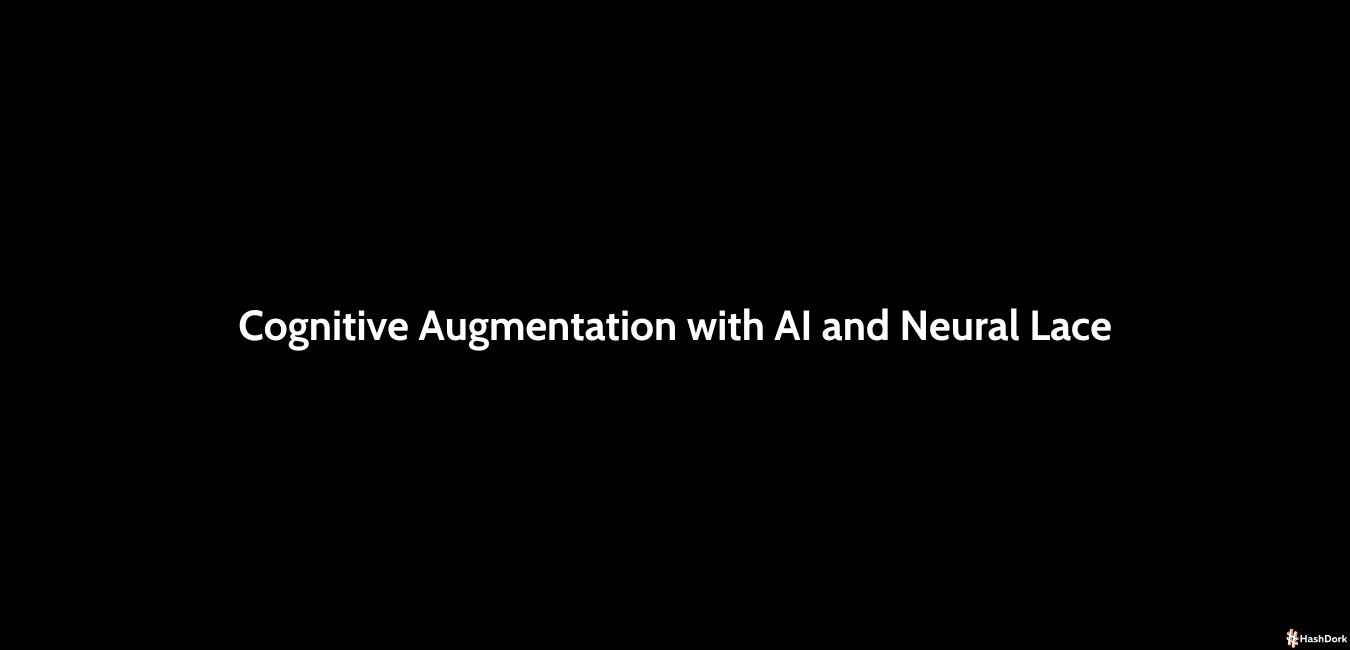The integration of artificial intelligence with neural lace technology is at the forefront of a groundbreaking combination with cognitive augmentation. This collaboration represents an enormous leap forward in the field of brain-computer interfacing.
We are bringing in a new era in which human intelligence can be enlarged beyond conventional limitations.
As AI permeates the field of neuroscience, it promises to uncover previously unexplored potentials in learning, and creativity.
The synergistic marriage of AI with neural lace paints an enticing picture of a future in which human intellect is boosted to unimaginable heights, stretching the boundaries of human-machine cooperation and changing the very essence of what it means to be human.
In this post, I will explore the fascinating possibilities that exist at the crossroads of AI and neural lace, investigating the power of cognitive augmentation and the implications it holds for our species’ cognitive evolution.
Let’s start with some basics and explore the terms first.
What Exactly is Cognitive Augmentation?
In essence, cognitive augmentation is an attempt to use implant technology to extend human sensory capacities and improve cognitive processes.
It is a cutting-edge investigation that goes beyond neuroplasticity and aims to add new senses to the brain in addition to rewiring the ones that are already there.
Cognitive augmentation seeks to support humans with special improved skills.
By giving people these skills that go beyond the constraints of their basic human senses, cognitive augmentation seeks to push the bounds of human cognition. Cognitive augmentation takes a more novel approach by directly interacting with the brain and extending its capacities using implant technology.
This ground-breaking endeavor explores areas that were previously the seemed as science fiction, imagining a time when people can perceive the world and engage with it in ways that were previously unthinkable.
According to scientists, human enhancement through the use of artificial body parts is imminent, and new limbs could be created to improve our skills.
For instance, a 3D-printed thumb developed by Dani Clode, a designer and associate professor of Tamar Makin at Cambridge University, can be fitted to any hand and is useful for a variety of activities, including helping electrical engineers solder and holding plates for waiters.
In this case, technology is completely integrated with the human body, enhancing our talents and productivity in particular circumstances and ushering in a new era of human-machine symbiosis. This example illustrates the possibilities of cognitive augmentation.
A Redefined Brain-Computer Interface: Neural Lace
Neural lace can be a bridge between cognitive augmentation and human-machine symbiosis. It is a theoretical brain-computer interface concept that involves the implantation of a network of nanoscale electrodes into the human brain.
Through the use of cutting-edge technology, bidirectional communication between the brain and external equipment is intended to be made possible.
A new era of human-machine cooperation and potential cognitive enhancement would be possible thanks to the neural lace, which would enable the brain to communicate with artificial intelligence systems, access information, and enhance cognitive capacities.
The implantation of a network of nanoscale electrodes into the human brain is a theoretical brain-computer interface concept known as neural lace. This cutting-edge technology seeks to establish a seamless connection between the brain and external equipment, allowing for bidirectional communication.
The neural lace would allow the brain to interface with AI systems, access information, and expand cognitive capacities, ushering in a new era of human-machine cooperation and potential cognitive augmentation.
Enhancing Cognitive Function to Increase Human Intelligence
A brave new frontier in developing human intelligence and cognitive skills is cognitive augmentation.
Cognitive augmentation aims to extend the boundaries of human cognition beyond what was previously thought to be feasible by merging artificial intelligence (AI) with the human brain through neural lace technology.
Individuals can acquire a great amount of knowledge, process data more effectively, and take on challenging problem-solving activities when AI is used as a helpful cognitive improvement tool.
Cognitive augmentation has the potential to alter many industries, from healthcare and education to research and artistic efforts, thanks to this symbiotic interaction between human intelligence and AI.
The Neural Lace Promise: A Seamless Interface
The concept of neural lace, a breakthrough brain-computer interface that acts as the neural bridge between the human brain and AI systems, is at the heart of cognitive augmentation.
Once implanted in the brain, neural lace forms a direct and seamless connection with the brain’s neural pathways, allowing for bidirectional communication.
This connectivity enables the brain to easily access external AI systems while also giving AI real-time insights into human cognitive states.
Because of its non-invasive and minimally disruptive nature, neural lace is an excellent candidate for cognitive augmentation without the need for complex and risky surgical procedures.
Using AI to Improve Cognitive Abilities
The incorporation of AI into neural lace allows for cognitive augmentation through individualized cognitive assistance.
Individual learning styles and preferences can be accommodated by AI algorithms, which provide personalized knowledge and aid in problem-solving activities.
As AI operates as a virtual mentor, teaching individuals to reach their full cognitive potential, this tailored approach to cognitive enhancement can lead to considerable increases in learning, memory, and creative thinking.
Problem-Solving and Decision-Making Enhancement
Cognitive augmentation using AI and neural lace has the potential to transform problem-solving and decision-making processes. AI-powered neural lace can help people analyze complex data sets, detect trends, and generate novel solutions.
This cognitive boost has far-reaching consequences in a variety of industries, including banking, research, and technology development, where complex problem-solving and speedy decision-making are critical for success.
Brain-Boosting Technology: Improving Memory and Learning
Brain-boosting technologies, which are a manifestation of cognitive augmentation using AI and neural lace, are helping us understand human cognition. Memory prostheses, or brain implants that improve memory function, have been developed by researchers at the University of Southern California.
The prosthesis can stimulate the brain during memory recall by capturing neural activity during memory encoding.
This successfully boosts memory performance. Initial tests on participants with memory problems yielded encouraging findings, with memory recall accuracy increasing by about 40%. This cutting-edge technology can transform education and assist people suffering from memory impairments in regaining cognitive functions.
Brain-Computer Communication Neural Lace
The science fiction-inspired neural lace concept is becoming a reality. The University of California, Berkeley, researchers have made great progress by inventing a flexible neural lace mesh that can be injected into the brain.
This mesh is capable of detecting and stimulating cerebral activity, creating a bidirectional link between the brain and external equipment.
The potential uses of neural lace are numerous, ranging from restoring movement and feeling to enabling direct brain-controlled communication for those with speech problems.
As neural lace technology progresses, it offers up new avenues for cognitive augmentation, in which the brain can interact with AI systems in real-time, improving problem-solving and decision-making abilities.
Cognitive Prosthetics: Increasing Human Ability
Cognitive prosthetics, a subset of cognitive augmentation, is concerned with developing brain-computer interfaces to restore or augment human capacities. A team of experts at Stanford University, for example, has developed a “brain pacemaker” for people suffering from Alzheimer’s disease.
This device seeks to boost cognitive performance and minimize the effects of memory loss by activating the brain’s memory region.
Similarly, University of Pennsylvania researchers are investigating brain implants that improve learning ability. Subjects enhanced their performance and retention by using real-time electrical stimulation during learning activities.
These cognitive prostheses demonstrate how artificial intelligence-assisted neural lace can bridge the gap between human potential and technical capabilities.
Improved Brain-Machine Connectivity
The era of cognitive enhancement has been here thanks to recent technical developments that have improved brain-machine communication. One important advancement is the use of brain-computer interfaces to connect our brains with computers.
Already, people with severe paralysis can manipulate a cursor on a screen, and some of them have used these interfaces to move robotic limbs or fly airplanes.
Researchers have also employed brain-computer interfaces to transmit information to the brain, regain hearing or touch, and treat tremors brought on by diseases like Parkinson’s disease. The basis for continued cognitive improvement is this two-way communication between brains and technology.
Non-Invasive Brain-Zapping using Transcranial Direct Current Stimulation (tDCS)
Transcranial direct current stimulation (tDCS), which involves passing modest electrical currents via the scalp, is one of the non-invasive methods being investigated by researchers. The objective is to enhance cognitive abilities including memory and learning.
However, research into the efficacy of tDCS for improving cognition is still ongoing. While some researchers and home brain hackers are optimistic about its possibilities, more study is required to fully comprehend its long-term effects.
Prospects for Cognitive Augmentation in the Future: AI-Powered Learning and Problem Solving
The combination of cognitive augmentation, AI, and neural lace opens up new avenues for improving human learning and problem-solving abilities.
AI-powered learning platforms could change teaching methods and content delivery based on real-time cognitive data to tailor educational content to individual cognitive profiles.
This tailored method has the potential to change education by increasing the efficiency and effectiveness of learning.
Furthermore, AI-augmented problem-solving technologies could help people tackle complicated challenges by providing insights and producing novel solutions based on large datasets and predictive algorithms.
Neural Lace Enhances Creativity and Innovation
The promise of neural lace technology, which seamlessly connects the human brain to AI systems, is that it will enable unparalleled levels of creativity and innovation.
Neural lace could enable humans to approach creative efforts with a broader cognitive landscape by providing direct access to vast libraries of knowledge, artistic inspiration, and varied perspectives.
Writers, artists, designers, and inventors could use AI-generated insights and aesthetic references to speed up the creative process and result in new expressions of human imagination.
Increased Communication and Collaboration
AI and neural lace integration have the ability to transform communication and collaboration. Individuals could interact via thought-based messaging with direct brain-computer interfaces, allowing for the smooth transfer of information and ideas.
In professional situations, this could improve collaboration by allowing teams to instantly communicate thoughts and ideas.
Individuals with speech problems or circumstances that hinder traditional communication may also find new ways to express themselves and interact.
Conclusion
In conclusion, cognitive augmentation with AI and neural lace has enormous promise for transforming the future of human intelligence and engagement with technology.
New views in learning, problem-solving, creativity, and medical applications arise as we uncover the potential of brain-computer interfaces and seamless interaction with AI systems.
Personalized learning platforms, AI-enhanced artistic activities, and sophisticated medical diagnostics are just a few of the disruptive possibilities that await.
The path to cognitive enhancement is one of exploration, difficulties, and immense promise.
Making sure that these technical breakthroughs are in line with human values and goals, necessitates interdisciplinary cooperation, ethical reflection, and careful control.
We can create a future where the merger of human intelligence with AI skills allows us to conquer new obstacles, ushering in an era of human-machine symbiosis that benefits all of mankind, by embracing cognitive augmentation responsibly.
We must travel this revolutionary path with wisdom, compassion, and a common goal of developing human potential for the benefit of our global community.






Leave a Reply